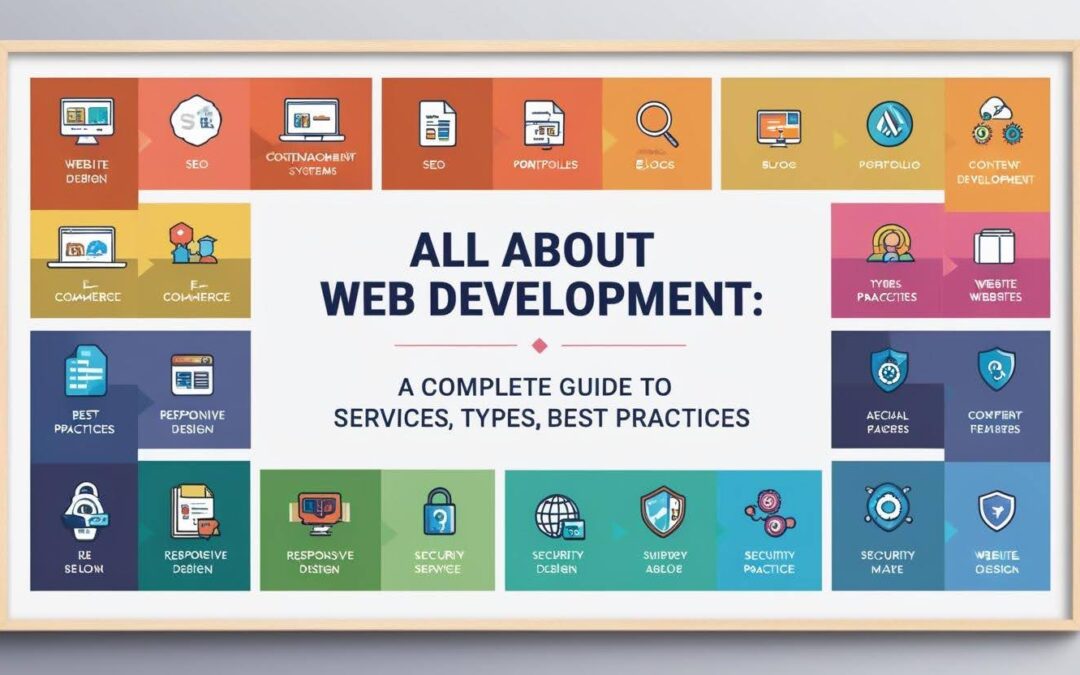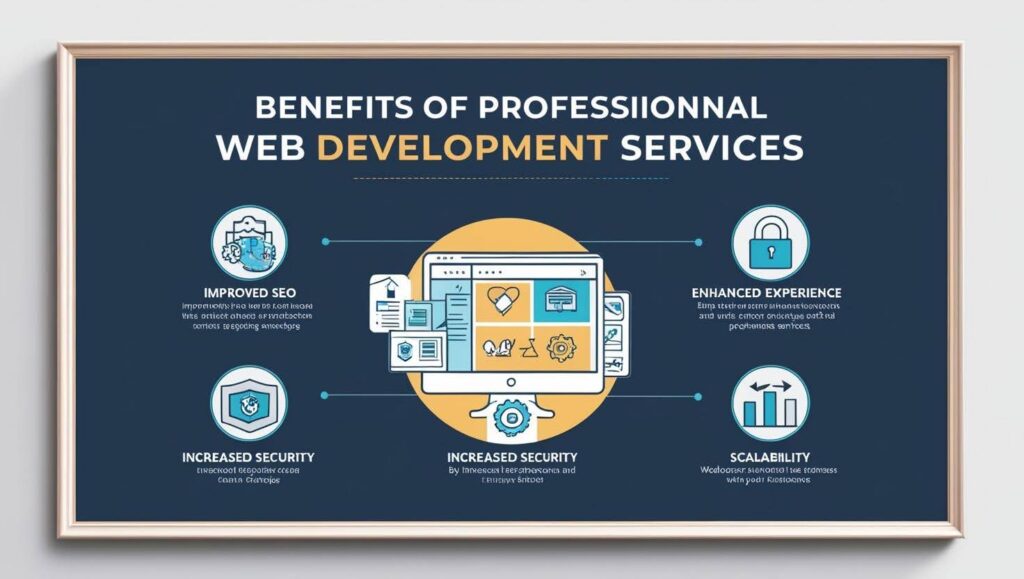
All About Web Development: Skills, Careers, Tools & Future Trends
Imagine waking up in a world without websites. No online shopping, no social media, no quick Google searches to find answers in seconds. Want to book a flight? You’d have to visit a travel agency. Need to transfer money? A trip to the bank is unavoidable. Even something as simple as ordering food would mean flipping through paper menus and making a call instead of a few taps on your phone. Sounds frustrating, right?
Web development is what keeps the digital world spinning. Every website you visit, from massive e-commerce platforms like Amazon to personal blogs, is the result of web developers bringing ideas to life through code. It’s an essential skill that powers businesses, connects people, and even creates opportunities for individuals to earn a living online.
Whether you’re just dipping your toes into the world of coding or you’re an industry expert looking to sharpen your skills, this guide is for you. We’ll break down the core principles of web development, explore different roles in the field, and answer key questions—like how to start, what tools to use, and whether web development is a good career choice.
So, if you’ve ever wondered how websites are built or considered a future in tech, you’re in the right place. Let’s dive in! 🚀
1. Understanding Web Development
What is Web Development?
Have you ever wondered how websites come to life? Every time you click a link, fill out a form, or watch a video online, web development is at work behind the scenes. Web development is the process of building, designing, and maintaining websites, ensuring they are functional, user-friendly, and visually appealing.
At its core, web development involves writing code that tells a website what to do. It can range from creating a simple personal blog to developing complex platforms like social media networks or e-commerce sites. Developers use various programming languages like HTML, CSS, and JavaScript, along with frameworks and tools, to bring digital experiences to users worldwide.
But web development isn’t just about making websites exist—it’s about ensuring they run smoothly, load quickly, and provide a seamless experience for visitors.
Web Development vs. Web Design: What’s the Difference?
Many people use the terms web development and web design interchangeably, but they’re actually quite different. Think of a website like a house:
- Web developers are the builders—they lay the foundation, install the plumbing, and make sure everything functions properly.
- Web designers are the interior decorators—they focus on the look and feel, making the space visually appealing and user-friendly.
In other words, web development is all about the technical side—writing code, handling databases, and ensuring functionality—while web design focuses on aesthetics, colors, fonts, and layouts to create an engaging user experience.
The Evolution of Web Development
Web development has come a long way since the early days of the internet. Back in the ‘90s, websites were simple, static pages with basic text and images. There was no scrolling social media feeds, no interactive web apps—just plain HTML pages linked together.
Fast forward to today, and we have dynamic, highly interactive websites that adjust to user preferences, work seamlessly on mobile devices, and even incorporate artificial intelligence. Innovations like JavaScript frameworks (React, Vue, Angular), cloud computing, and machine learning have transformed the way we build and experience the web.
As technology evolves, so do user expectations. People demand faster load times, personalized content, and flawless performance across different devices. That’s why web developers need to stay updated with the latest trends and advancements in the field—because in the digital world, change is the only constant.
2. The Three Main Roles in Web Development

Web development isn’t a one-size-fits-all job. It’s divided into three main roles, each playing a crucial part in how a website functions. Some developers specialize in just one area, while others master them all. Let’s break it down.
Front-End Development: The Visible Side of the Web
Ever visited a website and admired its sleek design, smooth animations, or intuitive navigation? That’s the work of front-end developers! They focus on the parts of a website that users interact with—buttons, menus, images, and text layouts. Their job is to create an engaging, responsive, and user-friendly experience.
To bring websites to life, front-end developers use:
- HTML (HyperText Markup Language): Defines the structure of a webpage, like headings, paragraphs, and links.
- CSS (Cascading Style Sheets): Controls the look and feel—colors, fonts, layouts, and animations.
- JavaScript: Adds interactivity, enabling features like dropdown menus, pop-ups, and dynamic content updates.
- Frameworks & Libraries: Tools like React, Vue, and Angular help developers build complex, efficient web applications faster.
In short, front-end developers ensure that when you click a button, scroll through a page, or hover over an image, everything works smoothly and looks great.
Back-End Development: The Power Behind the Scenes
If the front end is the face of a website, the back end is its brain. Back-end developers handle everything that happens behind the scenes—server operations, databases, and application logic. They make sure data is processed correctly, security is tight, and everything runs efficiently.
Key technologies in back-end development include:
- Databases: Store and manage website data. Examples include MySQL (structured data) and MongoDB (flexible, document-based storage).
- Programming Languages: Used to build server-side logic, including Python, Node.js, PHP, and Ruby.
- APIs (Application Programming Interfaces): Allow communication between different software systems, such as connecting a website to a payment gateway or an external service like Google Maps.
- Server Management: Ensures websites stay online, handle traffic loads, and remain secure.
Think of a login page: when you enter your username and password, the back end checks the database, verifies your credentials, and grants you access. Without back-end development, websites wouldn’t be able to store or process any information.
Full-Stack Development: The Best of Both Worlds
A full-stack developer is like a Swiss Army knife of web development—they handle both front-end and back-end tasks. They build the user interface, manage databases, and ensure the website functions smoothly from start to finish.
Full-stack developers have knowledge of:
- Front-end technologies (HTML, CSS, JavaScript, React, Vue, Angular)
- Back-end programming languages (Python, Node.js, PHP, Ruby)
- Databases and server management
Because they understand the full development process, full-stack developers are highly valued in the industry. They can build entire applications independently and troubleshoot issues across the whole system.
Which Role is Right for You?
- If you enjoy designing, animations, and making things look good, front-end development might be your path.
- If you prefer problem-solving, data handling, and working with servers, back-end development could be your thing.
- If you love variety and want to build complete applications from start to finish, full-stack development is a great choice.
No matter which path you choose, all three roles are essential for creating functional, modern websites. The best part? You can always start with one and expand your skills over time!
3. Is Web Development Hard?
The short answer: it depends.
Web development isn’t something you can master overnight, but it’s far from impossible. Like any skill, it requires patience, practice, and a willingness to learn. Some people pick it up quickly, while others take longer to grasp the concepts. It all comes down to your approach and commitment.
What Makes Web Development Challenging?
If you’re just starting out, you might find certain aspects of web development a bit tricky. Here are some of the common challenges beginners face:
- Learning Multiple Technologies: Unlike some fields where you focus on just one tool, web development requires learning a mix of languages and frameworks. HTML, CSS, and JavaScript are the foundation, but you’ll also encounter databases, APIs, and various libraries and frameworks.
- Debugging Code: Writing code is one thing—fixing broken code is another. Debugging is a huge part of a developer’s job, and it can sometimes feel frustrating when things don’t work as expected.
- Keeping Up with Evolving Tech Trends: The tech world moves fast! New frameworks, libraries, and best practices emerge all the time. Staying updated requires continuous learning, but that’s also what keeps it exciting.
The Good News? It’s Totally Doable!
While web development has its challenges, there are tons of resources available to help you succeed. Whether you prefer online courses, coding bootcamps, YouTube tutorials, or hands-on projects, there’s no shortage of ways to learn.
The key to mastering web development is consistent practice. Start small—build simple web pages, experiment with styling, and gradually move on to interactive features. Before you know it, you’ll be creating full-fledged websites and applications!
4. Types of Web Development & Their Applications
Not all websites are built the same. Some are simple and static, while others are highly interactive and data-driven. The type of web development you choose depends on your project’s goals, the audience’s needs, and the level of complexity required.
1. Static Websites – Simple and Reliable
Imagine a digital brochure—one that presents information but doesn’t change unless manually updated. That’s a static website. These websites consist of fixed content and are typically built using HTML, CSS, and a bit of JavaScript.
🔹 Best for: Personal portfolios, small business sites, landing pages, or informational blogs.
🔹 Example: A basic “About Us” page for a local bakery.
2. Dynamic Websites – Interactive & Personalized
Unlike static sites, dynamic websites change and adapt based on user interactions. They pull content from a database and update in real time. Social media platforms, news sites, and dashboards are great examples.
🔹 Best for: Blogs with user comments, forums, social media platforms, and interactive dashboards.
🔹 Example: Facebook, Twitter, or a news website that updates content automatically.
3. E-commerce Websites – Selling Online Made Easy
If you’ve ever shopped online, you’ve used an e-commerce website. These platforms handle product listings, shopping carts, and secure payment processing. E-commerce sites require both front-end (user interface) and back-end (order processing and database management) development.
🔹 Best for: Online stores, marketplaces, or businesses selling products/services online.
🔹 Example: Amazon, Shopify, or a clothing brand’s online store.
4. Web Applications – More Than Just Websites
A web application is an advanced form of a website that functions like a software application. Instead of just displaying content, it allows users to perform tasks, store data, and interact in real time. Think of platforms like Gmail, Google Docs, or Trello—these aren’t just websites; they’re powerful tools designed for productivity.
🔹 Best for: Task management tools, cloud-based software, and collaboration platforms.
🔹 Example: Google Drive, Notion, or an online banking portal.
Which Type is Right for You?
Choosing the right type of web development depends on your project’s purpose and your audience’s needs. A small business might do well with a static website, while a growing company might need an e-commerce site or a dynamic web application.
5. Core Principles of Web Development
Building a great website isn’t just about writing code—it’s about ensuring a smooth, secure, and scalable experience for users. Here are the key principles every developer should follow:
1. Performance & Speed
Nobody likes a slow website. Users expect pages to load in seconds, or they’ll leave. To keep things fast, developers use techniques like image optimization, caching, and minimizing unnecessary code. A well-optimized site enhances user experience and even boosts search engine rankings.
2. User Experience (UX) & Accessibility
A website should be easy to navigate and usable by everyone, including individuals with disabilities. This means clear layouts, readable fonts, mobile responsiveness, and features like alt text for images and keyboard navigation support. A good UX keeps visitors engaged and coming back.
3. Security & Data Protection
With cyber threats on the rise, security is a top priority. Developers must implement SSL certificates, encrypt sensitive data, and prevent vulnerabilities like SQL injection and cross-site scripting (XSS). A secure website protects both the business and its users.
4. Scalability & Maintainability
Websites should be built to grow and evolve. This means using clean, well-structured code, modular components, and scalable infrastructure. A properly designed site is easier to update, expand, and troubleshoot in the long run.
Mastering these principles ensures that your website isn’t just functional—but also fast, user-friendly, secure, and future-proof!
6. Best Software & Tools for Web Development

Web development is made easier with the right set of tools. From writing code to testing and deployment, here are some must-have tools every developer should know:
1. Code Editors
A good code editor makes writing and managing code much easier. Popular options include:
- VS Code – Feature-rich, lightweight, and packed with extensions.
- Sublime Text – Fast and customizable, great for quick coding.
- Atom – Open-source and highly flexible (though no longer actively developed).
2. Frameworks & Libraries
Frameworks speed up development by providing pre-built structures and components:
- React – A powerful JavaScript library for building interactive UIs.
- Angular – A full-fledged front-end framework by Google.
- Laravel – A PHP framework for creating robust web applications.
3. Testing & Debugging
Finding and fixing errors is a huge part of web development. These tools help:
- Chrome DevTools – Inspect and debug websites in real time.
- Postman – Essential for testing APIs and backend services.
4. Hosting & Deployment
Once your site is ready, you need a place to host it. Here are top choices:
- Netlify – Simple and great for static sites.
- Vercel – Ideal for deploying Next.js and modern web apps.
- AWS – Scalable cloud hosting for large-scale applications.
Having the right tools in your arsenal can boost productivity, streamline development, and improve overall website performance. Choose what works best for your project and skill level!
7. Website Builders vs. Custom Development
When creating a website, you have two main approaches: using website builders or coding from scratch. Each has its pros and cons.
Website Builders (Easy but Limited)
Platforms like Wix, Squarespace, and Shopify make it simple to build a website without coding. They’re great for beginners, small businesses, and quick projects. However, they come with limited customization, dependency on the platform, and potential scalability issues.
Custom Development (Flexible but Complex)
Building a website from scratch with HTML, CSS, JavaScript, and backend technologies gives you full control over design, functionality, and performance. While this method requires more time and technical skills, it allows for greater flexibility, scalability, and security—making it ideal for larger, more customized projects.
Choosing between the two depends on your needs: quick and easy vs. full control and flexibility.
8. How to Start Learning Web Development
If you’re new to web development, follow this roadmap to get started:
- Begin with the Basics – Learn HTML, CSS, and JavaScript, the foundational languages of the web.
- Practice with Small Projects – Build simple websites, landing pages, and interactive elements to gain hands-on experience.
- Explore Frameworks & Libraries – Once comfortable, dive into tools like React, Bootstrap, and Tailwind CSS to enhance your development skills.
- Create a Portfolio – Showcase your projects on GitHub or a personal website to demonstrate your skills to potential employers or clients.
- Learn Version Control – Get familiar with Git and GitHub to manage code changes and collaborate effectively.
With patience and consistent practice, you’ll be well on your way to becoming a web developer.
9. Career in Web Development: Is It Worth It?

If you’re considering web development as a career, you’re in luck—it’s a field with high demand, competitive salaries, and plenty of growth opportunities.
Job Prospects
Web developers are needed across various industries, from startups to large tech companies. Freelancing is also a popular route, offering flexibility and the potential to work with global clients.
Salaries & Growth Potential
Web development is a well-paying career, with salaries varying based on expertise, location, and specialization. As you gain experience, you can move into senior roles, become a tech lead, or even start your own development agency.
Most In-Demand Specializations
- Full-Stack Development – Master both front-end and back-end technologies.
- AI-Powered Web Apps – Build intelligent, data-driven applications.
- Cybersecurity – Focus on securing websites against cyber threats.
With constant advancements in technology, web development continues to evolve, ensuring long-term career viability.
10. Offering Web Development Services
If you want to freelance or start a web development business, here’s how to get started:
Build a Strong Portfolio – Showcase your best projects to attract clients.
Set Your Pricing Model – Choose between hourly rates, fixed project fees, or retainer-based pricing.
Market Your Skills – Use social media, job boards, and networking to find clients and grow your business.
With the right strategy, web development can become a lucrative and fulfilling career.
11. Cost of Web Development Training
There are multiple ways to learn web development, ranging from free resources to formal education.
Free Learning Resources
- YouTube tutorials – Great for beginners.
- FreeCodeCamp – Offers structured, project-based learning.
- MDN Docs – Comprehensive documentation for web technologies.
Paid Options
- Udemy & Coursera – Affordable online courses.
- Coding Bootcamps – Intensive, career-focused training with job placement support.
University Degrees
A computer science degree provides a deep understanding of development but is the most time-consuming and expensive option.
Ultimately, your learning path depends on your budget, goals, and preferred learning style.
12. How to Build a Website from Scratch
Building a website from the ground up may seem daunting, but breaking it into steps makes it manageable.
- Choose a Domain & Hosting Provider – Services like GoDaddy, Namecheap, and Bluehost can help.
- Set Up the Front-End – Use HTML, CSS, and JavaScript for structure, styling, and interactivity.
- Use Frameworks or CMS (if needed) – Tools like React, WordPress, or Django can speed up development.
- Deploy the Website – Host your site using GitHub Pages, Netlify, or AWS.
With practice, you’ll be able to build and launch websites efficiently.
13. Future of Web Development
The web development landscape is constantly evolving. Here are some key trends shaping the future:
AI & Automation – AI-powered tools are streamlining coding, making development faster.
Progressive Web Apps (PWAs) – These hybrid web apps provide a native app-like experience.
Web3 & Decentralization – Blockchain is paving the way for more secure, decentralized websites.
Voice & Gesture Control – Websites will become more accessible with voice and motion-based interactions.
Staying updated on these trends will keep you ahead in this ever-growing industry.
Conclusion
Web development is an exciting, ever-evolving field with limitless opportunities. Whether you want to learn it as a hobby, switch careers, or scale your business, there’s never been a better time to dive in. With the right resources, patience, and practice, you can master web development and open doors to endless possibilities.
So, what’s stopping you? Start coding today, and who knows? The next great website could be yours!





